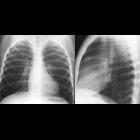kongenitales mesoblastisches Nephrom






Mesoblastic nephroma, also sometimes known as a congenital mesoblastic nephroma (CMN) or fetal renal hamartoma, is, in general, a benign renal tumor that typically occurs in utero or in infancy.
Epidemiology
It is the commonest neonatal renal tumor. Diagnosis is usually made in the antenatal period or immediately after birth. The tumor accounts for approximately 3-6% of all renal neoplasms in children . Approximately 50% occur during the neonatal period and most of the cases are diagnosed within the first 3 months of life . Overall, 90% of the cases are discovered by the age of 1 year.
Clinical presentation
Most common clinical presentation is a palpable abdominal mass, with hematuria occurring less frequently.
Pathology
It is a mesenchymal tumor. Macroscopically the tumor is a solid un-encapsulated mass which often occurs near the renal hilum. It tends to invade the surrounding structures and renal parenchyma. Hemorrhage and necrosis are infrequent. Histologically, it is typically composed of connective tissue growing between nephrons, usually replacing most of the renal parenchyma.
The classic cytological description of the lesion is that of cellular clusters of spindle cells, mild nuclear pleomorphism, mitotic activity and no blastema.
Subtypes
There are two main pathological variants:
- classic mesoblastic nephroma: accounts for less than one third of cases of CMN
- cellular mesoblastic nephroma
- more heterogeneous in appearance on imaging
- tends to be larger and presents later in infancy (> 3 months of life )
- may exhibit aggressive behavior including vascular encasement and metastasis
Associations
- polyhydramnios
- fetal hypercalcemia
Radiographic features
Plain radiograph
Non specific and not an imaging modality of choice but if performed incidentally in a neonate, may demonstrate a soft tissue mass displacing bowel. Calcification is rare .
Ultrasound
Sonographic appearance can vary depending on the pathological variant . In general it is a well-defined mass with low-level homogeneous echoes. The presence of concentric echogenic and hypoechoic rings can be a helpful diagnostic feature in the classic subtype, but may also be seen in the cellular subtype . A more complex pattern due to hemorrhage, cyst formation and necrosis can also be seen and tends to favor the cellular variant. Color Doppler interrogation may show increased vascularity. Uncommonly the tumor may appear predominantly cystic .
Antenatal ultrasound may also show evidence of associated polyhydramnios.
CT
Usually not performed in an antenatal situation. Solid hypoattenuating renal lesion with variable contrast enhancement. Cystic areas, necrosis, and hemorrhage are uncommon (only in cellular type) . Typically no calcification seen. Hyperdense foci, however, may be seen related to hemorrhage in the cellular subtype .
MRI
Best modality for cross sectional imaging antenatally and can better assess anatomical relationships.
Unless complicated necrosis and hemorrhage (both generally uncommon), general signal characteristics within the mass include:
- T1: iso to hypointense , may show hyperintense foci related to hemorrhage in the cellular subtype
- T2: variable, from markedly hypointense to hyperintense
- DWI: shows restricted diffusion in the solid portion of the tumor, likely related to increase cellularity
Treatment and prognosis
The majority are benign tumors and have a favorable outcome. The cellular variant can, at times, be aggressive. As a surgical option, a nephrectomy usually suffices.
Complications
Potential complications with large tumors include:
- abdominal dystocia at birth
- arterio-venous shunting with subsequent development of hydrops fetalis
Differential diagnosis
- Wilms tumor
- renal clear cell sarcoma
- rhabdoid tumor
See also
Siehe auch:
- Hydrops fetalis
- Polyhydramnion
- Nephroblastom
- pädiatrische Nierentumoren
- klarzelliges Nierenzellkarzinom
- fetale Tumoren
- maligner rhabdoider Tumor der Niere
und weiter:

 Assoziationen und Differentialdiagnosen zu kongenitales mesoblastisches Nephrom:
Assoziationen und Differentialdiagnosen zu kongenitales mesoblastisches Nephrom:



